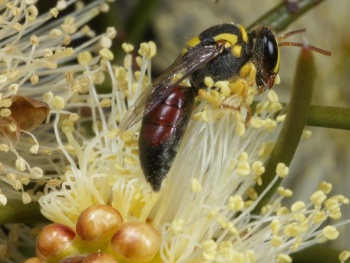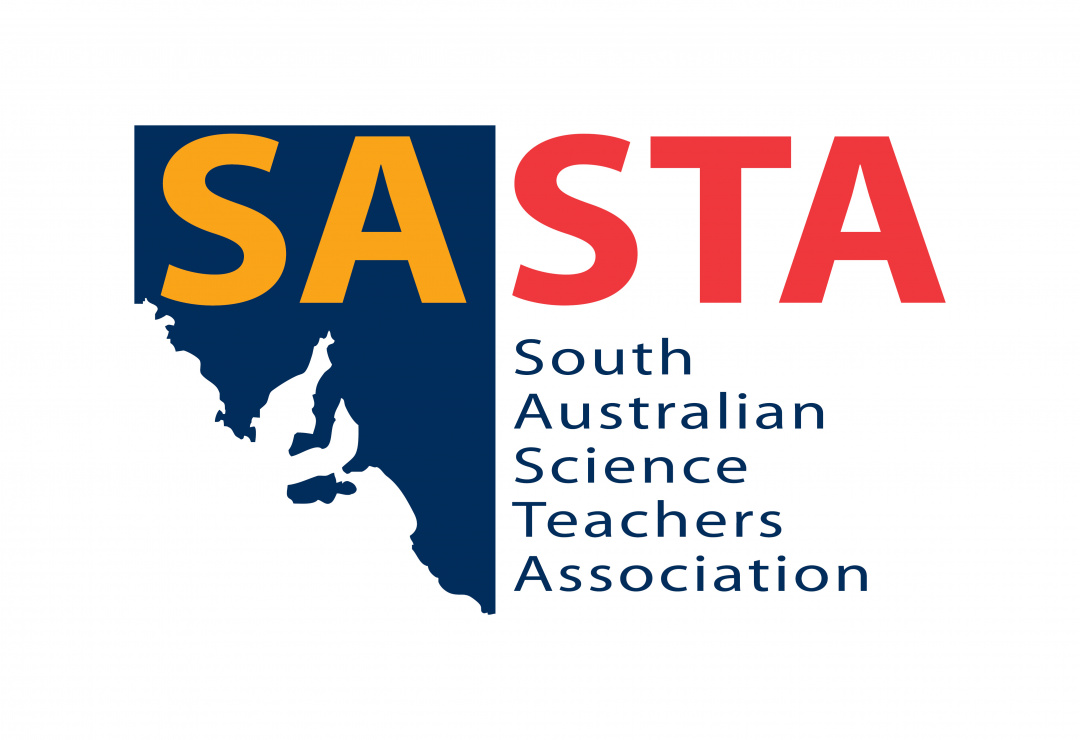Posted by SASTA
on 16/09/2024

Dr Katja Hogendoorn, The University of Adelaide
While climate change and declines in biodiversity are inevitable, and the lack of adequate action drives some of us to despair, we can all make small contributions to help mitigate some of the effects. Taken together, these small contributions have a positive impact on the biodiversity around us, and they make us feel better. As a native bee specialist, I try to stimulate people who care about nature to plant food for bees, and specifically for those bee species that are doing it tough. This doesn’t only help bees, but insects in general, which are important for their ecosystem services and as food for vertebrates. The classroom offers a great opportunity to raise awareness and engage in meaningful protection of bees. This article explains.
What are bees?
Upon hearing the word ‘bees’, most people think of honey bees, which make up a tiny part of all bee species. Worldwide, there are about 20,000 known bee species, but only 16 of these are honey bee species. The European honey bee is the best known species as it has been domesticated, is our main crop pollinator worldwide, and produces honey. But honey bees are an exception in the bee world: around 95% of bee species are solitary -they do not have a queen and workers, they don’t produce honey and many of them are not attracted to introduced crops.
All bees rely on floral resources to feed themselves and their offspring. Pollen is their source of protein; nectar provides the carbs.
Are bees in decline?
We often hear that bees are in decline. This is true, but it does not apply to the European honey bee. The number of managed honey bee hives have doubled since 1960, despite the global spread of the Varroa mite. Honey bees are very generalist feeders that can be maintained in a range of landscapes, and we know how to breed them.
Most Australian native bees rely solely on Australian native plant species. The bee species that are most in decline are those that specialise on a limited number of related plant species for their pollen supply. These specialists are the nerds of the bee world: Among a broad spectrum of introduced and native flowering plants, they are extremely fussy eaters. Due to coevolution, their larvae are excellent at digesting pollen from these plants, but they cannot cope with the toxins in other pollen species.
Pollen specialisation is surprisingly common among bees, and particularly in Australia. There are more than 2,000 known Australian native bee species, and new species are still discovered regularly. More than half of these species specialise on one or a few plant genera for their choice of pollen. For example, nearly all bees in the endemic subfamily Euryglossinae (>400 species) are only ever seen foraging on plants in the Eucalyptus family, the Myrtaceae. Several other bee species depend solely on pollen from a single genus of plants such as Eremophila, Conospermum, Wahlenbergia, Banksia, or Verticordia.
Why are specialist bees specifically in decline? The answer to that question is quite simple. In many places, they cannot find sufficient flowering plants of the right species. As increasingly more land is appropriated for farming or urban development, the density of the specific flowering plants becomes too low to sustain a population.
What can we do?
 Provide nesting opportunities: Bee hotels and open soil
Provide nesting opportunities: Bee hotels and open soil
More and more school grounds host a bee hotel. Making one is a great hands-on activity, and a bee hotel is a beautiful tool to raise awareness about native bees and their needs. This is mainly because it makes the native bees, which can be small and often forage high up in the trees, more visible.
Nests of solitary bees contain a number of rooms, or brood cells. The female provisions each brood cell with pollen and nectar and then adds a single egg. Over time, the egg hatches, the larva eats the food supply and then moults into a pupa. The pupa develops and emerges as an adult the next year. The adults mate and the cycle starts again.
The bees that use bee hotels are mainly active during the summer months. During that time, one can see adult females flying in and out of the nest to provision brood cells for their offspring, and, often at the end of the day, diligently closing the nest entrance. Depending on the species, this is done with resin, leaves or self-produced cellophane. Therefore, when the bees are not active, one can deduce from the nest closure what type of bee has been provisioning the nest.
Last year, an honours student, Beck Stevens, investigated the occupation of bee hotels in Adelaide. Two of the more common species are the wasp mimic bee (Hyleoides concinna), a tiny masked bee called Hylaeus aralis and the large golden browed resin bee, Megachile aurifrons.
Beck found that the best substrates are (a) hardwood blocks drilled with holes of > 50 mm in length and diameters of 1-7 mm, and (b) bundles of dry bamboo with similar diameters, ends closed off by a node and pith cleaned out using a sate stick or knitting needle.
She also found that bee hotels in Adelaide have much better occupancy when they are placed in full shade. And smaller bee hotels attract fewer parasites.
While a bee hotel is useful for those species that nest above ground, about 70% of native bees dig their own nest in the ground. These species need access to open soil. When all soil is mulched or covered by thick lawn, this excludes ground nesting species from being present. So, the advice is, mulch where it is useful to protect the roots of shrubs and trees, but also leave some open soil.
Plant bee food
Some local guidelines for plantings for bees are being developed, including one for Adelaide and Mount Lofty Ranges. These guidelines provide general advice what to plant for native bees, but they don’t go into detail about what can be done for the specialists. Of the 20-odd species that use bee hotels in Adelaide, most rely on pollen from Myrtaceae, so if there is room, we need to make sure there are good Eucalyptus trees or Melaleuca bushes on or around the school grounds. After all, without a bee restaurant, the hotel would have limited occupancy.
What should we not do?
Apart from the above positive actions, there are also some things we shouldn’t be doing in our urban environment. Not using pesticides in the garden is an obvious one, but there are some detrimental actions that are less obvious.
Don’t take a honey bee hive
In addition, some people think that they are helping the bees by taking a bee hive, but urban beekeeping does not help bees. Honey bees have been introduced in the 1820s, for honey production and crop pollination, but they are not native to Australia. Helped by our mild climate and abundant nectar sources, the species quickly became invasive, and feral colonies are now a substantial environmental pest in many areas. Honey bees compete with birds and mammals for nesting hollows, with nectar feeding birds and insects for floral resources, they pollinate problematic weeds, such as Broom and Gorse, their presence can reduce the pollination of native plant species, and they transmit plant and bee diseases.
Importantly, in a situation where floral resources are scarce, and nectar production is affected by droughts, it doesn‘t make sense to add 20,000 – 40,000 mouths to feed. A hive removes about 120 kg of nectar and 8 kg of pollen from the ecosystem. We need honey bees for crop pollination, but urban beekeepers do not contribute to that. Whether or not beekeeping is desirable can be an interesting topic for a class discussion.
 Don’t plant introduced plants
Don’t plant introduced plants
Some gardening shops currently offer ‘wild bee’ seed mixes containing seed of showy introduced cottage plants. While this may help some of the more abundant generalist bees, such as honey bees and blue-banded bees, we can help all species, including the more endangered ones, but by focusing on local native plants. And we can go one step further by targeting the plants that specialist bees require. Over the last two years, a grant from Green Adelaide has supported me to run a project to promote plantings for one specialist bee species, the Golden Pea Bee. This project has involved councils, friends of parks groups and schools.
The full article including 'A Specialist in Focus: The Golden Pea Bee' can be found in the first edition of the SASTA Journal. This is available online in the member's area for SASTA Members.
Resources
- Bee hotel guide and further resources: https://www.aboutthegarden.com.au/how-to-make-a-native-bee-hotel/
- Short movie about pea bee: https://youtu.be/bm3qNUfIeQU
- My Pea bee journey: https://www.greenadelaide.sa.gov.au/news/get-the-buzz-on-a-project-bringing-the-bees-back-to-the-foothills
- Plantings for bees: https://www.wheenbeefoundation.org.au/our-work/projects/powerful-pollinators/ (scroll down to find guides for SA)
In this Section
Archive
- December 2025
- November 2025
- October 2025
- September 2025
- August 2025
- July 2025
- June 2025
- May 2025
- April 2025
- March 2025
- February 2025
- January 2025
- December 2024
- November 2024
- October 2024
- September 2024
- August 2024
- July 2024
- June 2024
- May 2024
- April 2024
- March 2024
- February 2024
- December 2023
- November 2023
- October 2023
- September 2023
- July 2023
- June 2023
- May 2023
- April 2023
- March 2023
- February 2023
- January 2023
- December 2022
- November 2022
- October 2022
- August 2022
- July 2022
- June 2022
- May 2022
- April 2022
- March 2022
- February 2022
- January 2022
- December 2021
- November 2021
- October 2021
- September 2021
- August 2021
- July 2021
- June 2021
- May 2021
- April 2021
- March 2021
- February 2021
- January 2021
- December 2020
- November 2020
- October 2020
- September 2020
- August 2020
- July 2020
- June 2020
- May 2020
- April 2020
- October 2018
- September 2018
- August 2018
- July 2018

